![]()
![]()
![]()
Use LEFT and RIGHT arrow keys to navigate between flashcards;
Use UP and DOWN arrow keys to flip the card;
H to show hint;
A reads text to speech;
64 Cards in this Set
- Front
- Back
|
The kidney has what two endocrine functions?
|
Renin angiotensin system - Blood pressure control
Erythropoietin - stimulates RBC production |
|
|
What is Epogen and who gets it?
|
Exogenous Erythropoietin
Pts with renal failure |
|
|
How often must renal failure patients be dialyzed?
|
A few times a week
|
|
|
What three things are kept in balance by the kidneys?
|
Fluids
Electrolytes pH |
|
|
Two of the three major functions of the renal system are maintaining electrochemical balance and endocrine functions. What is the third?
|
Degrading and eliminating metabolic and pharmacotherapeutic molecules
All of the above would be toxins |
|
|
In chronic disease, which functions would we want to monitor?
|
All of them! Malfunction of any of the functions indicate a problem.
|
|
|
Toxins are eliminated through what two renal processes?
|
Filtration (180 L/day)
Secretion (penicillin and asparagus) |
|
|
The conservation of salts, aminos, glucose and water is accomplished through what process?
|
Reabsorption
Amazingly efficient: 99% reabsorbed |
|
|
The kidneys receive what percent of cardiac output?
|
25%
Lungs get the most, roughly equal to everything else. Brain is next. |
|
|
How long does it take for all of the blood in the body to pass through the kidneys?
|
5 mins!
Dang, that's fast. |
|
|
The kidney is divided into the __ and the __.
|
Cortex and Medulla
|
|
|
The renal cortex is covered by how many tissue layers?
|
Two: Inner and Outer Layer of Capsule
Inner is myofibrils Outer is dense CT |
|
|
The __ contains renal artery, vein, lymph vessels and ureter.
|
Hilum.
This is the "input/output" portion of the kidney. |
|
|
The cortex contains _-__ renal pyramids.
|
6-12 pyramids.
|
|
|
What connects medulla with the cortex?
|
Medullary rays
|
|
|
The parts of the kidney that collect urine from the renal papilla and form the pelvis are called what?
|
Calyces
|
|
|
Renal __ is continuous with the ureter.
|
Pelvis
|
|
|
Define what is included in a renal lobe.
|
Renal pyramid and the underlying papilla with its minor calix.
|
|
|
A nephron and collecting duct are (together) called what?
|
Uriniferous tubule
|
|
|
The nephron begins with what structure?
|
Bowman's Capsule within the (renal) corpuscle
|
|
|
What is the sequence of specializations within a nephron
|
Proximal convoluted tubule
Thin loop of Henle Thick loop of Henle Distal convoluted tubule |
|
|
What are the two types of nephrons and what are their jobs?
|
Juxtamedullary (15%) - Maintain osmolarity gradient.
Cortical (85%) - Actual kidney functions. Their locations and the depths of their loops are described by their names, juxtamedullary = "close to the middle," and functions: Long, thin loops maintain salt gradient Short, thicker loops perform actual filtration. Don't memorize this stuff. Think about it! |
|
|
Renal arteries branch to
|
Interlobar arteries
|
|
|
Afferent and Efferent arterioles enter/exit the renal corpuscle where?
|
Vascular pole
|
|
|
Cortical and Juxtamedullary nephrons both give rise to capillary networks. What are they?
|
Cortical → peritubular networks
Juxtamedullary → vasa recta Recall that vasa recta surround Henle loops and play a role in maintaining the osmo. gradient. Recta = "straight," or if you like, "erect" |
|
|
What is the pathway of blood through the kidneys?
|
In: Renal artery → Interlobar artery → Arcuate artery → Interlobular artery →
→ peritubular networks, or → vasa recta Out: same way (backwards) - pn/vr → interlobular veins → arcuate veins → interlobar veins → Renal vein Note: InterLOBAR > InterLOBULAR |
|
|
The renal corpuscle is composed of what?
|
Glomerulus
Bowman's Capsule |
|
|
The renal corpuscle has two poles. What are they?
|
Vascular pole
Urinary pole |
|
|
What happens at the vascular pole?
|
Afferent arteriole carries blood into the glomerulus. Efferent arteriole carries blood away from the glomerulus.
|
|
|
Where is renal filtrate first collected?
|
Bowman's Space (Urinary Space) between Bowman's capsule and the glomerular tuft.
|
|
|
From the Bowman's Space, what is the next stop for the filtrate?
|
Proximal convoluted tubule
|
|
|
__ cells support the glomerulus and act as phagocytes.
|
Mesangial cells
|
|
|
Filtration occurs primarily in the basal lamina between the endothelium and __
|
Podocytes
|
|
|
Extensions of podocytes around the glomerular capillaries are called __
|
Pedicels
|
|
|
The basal lamina of the renal corpuscle consists of what four components?
|
Collagen IV
Laminin Fibronectin Polyanionic proteoglycan* *rich in heparin sulfate |
|
|
Describe the basal laminar filtration process of the renal corpuscles.
|
Collagen network traps molecules >60kD
Polyanions impede (-) charged particlesW |
|
|
What role do mesangial cells play in the filtration process?
|
Continuously reabsorb the basal lamina
|
|
|
What are filtration slits?
|
Spaces between pedicels
|
|
|
Filtrate passes through what three layers?
|
Capillary Fenestrae
Basal Lamina Filtration Slits |
|
|
What is the main site for reabsorption in the nephron?
|
Proximal tubules are not only the longest segment, but also possess large epi cells with prominent apical brush border.
|
|
|
O'Don says, "If there's crap in it, it's a __ tubule."
That's a quote referring to distinguishing this structure in lab. |
Proximal Tubule
|
|
|
What is the juxtaglomerular apparatus?
|
A key regulator of hormones involved with fluid balance including ADH.
|
|
|
What types of cellular elements are included in the juxtaglomerular apparatus and how are they interconnected?
|
Macula densa
Juxtaglomerular cells Extraglomerular mesangial cells These elements communicate via gap junctions |
|
|
What is renin?
|
Renin is an endocrine hormone released by the kidney.
It acts on adrenal medulla to release aldosterone - Increases resorption of Na Also converts Angiotensinogen to Angiotensin I |
|
|
Where does renin come from?
|
Juxtaglomerular cells release it. These are specialized smooth muscle cells in the walls of afferent (some efferent) arterioles.
|
|
|
What are medullary rays?
|
Aggregates of Henle loops, distal tubules and collecting ducts running between cortex and medulla.
"Ducts of a feather run together." - Infinite Wisdom of O'Don |
|
|
What is the primary job of Collecting tubules?
|
Reabsorption of H₂O.
ADH influences the permeability of these ducts, which steadily increase in diameter: Collecting ducts → Ducts of Bellini → Calyces |
|
|
Where do the collecting ducts end?
|
Renal papilla
|
|
|
What is the tip of the renal papilla called?
|
Area Cribrosa
|
|
|
The tissues from calyces on out to the bladder are lined with what type of epithelial cell?
|
All lined with transitional epi:
Calyces → r. pelvis → ureter → bladder |
|
|
Compare the muscles of the ureter to those found in the gut.
|
Upper ureter has only two layers.
Lower ureter has three layers: Long-Circular-Long like the gut tube, but unlike the gut the middle layer is longitudinally oriented. |
|
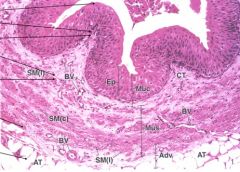
|
Ureter
|
|
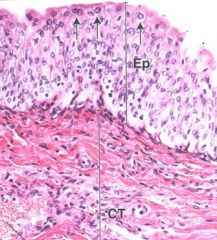
|
Transitional Epithelium
|
|
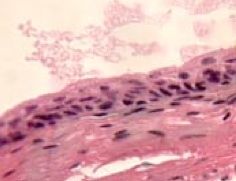
|
Transitional Epi, stretched
Note "junk" in the lumen, probably urine |
|

|
Bladder
|
|
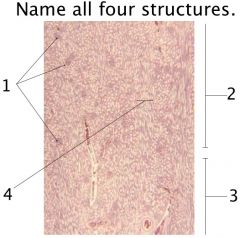
|

|
|
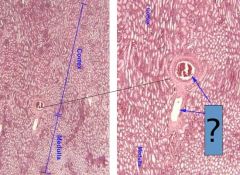
|

|
|
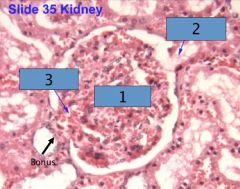
|

|
|
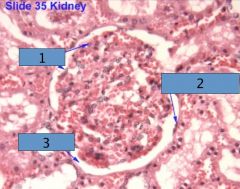
|

|
|
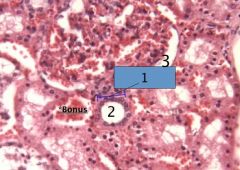
|

|
|
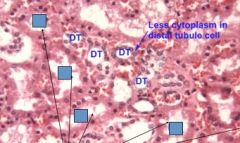
|

|
|
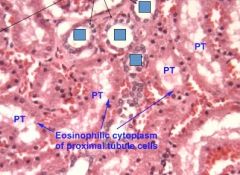
|

|
|
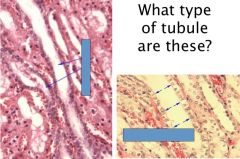
|

|
|

|
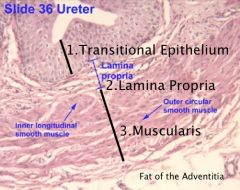
|

